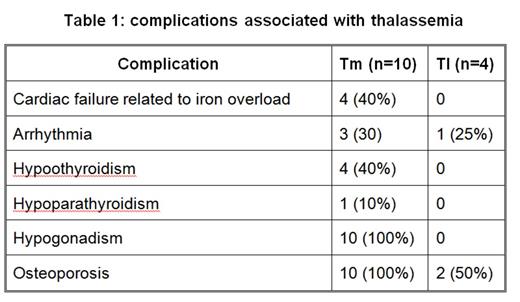Abstract
Introduction Survival of beta thalassemia major (TM) and intermedia (TI) patients have improved significantly over the past few decades as better treatment and follow up became available. However, complications are still common and affect patients’ quality of life, and systemic iron overload, particularly in the heart, liver, and endocrine organs, continues to be the main contributor to severe morbidity and early mortality in these patients. Traditionally, most thalassemia patients worldwide are treated in pediatric clinics by pediatricians. Consequently, in contrast to young patients, less data is available for complications and morbidity among adult TM & TI patients. We aimed to characterize disease and patients’ characteristics in patients >35 years of age.
Methods We retrospectively reviewed medical charts of all consecutive patients above the age of 35 years with TI/TM who were treated in a tertiary thalassemia center. Liver iron load was defined as at least one of the following: elevation of liver enzymes, signs of steatosis by sonography, and evidence of iron accumulation by T2* MRI. We used descriptive statistics to describe characteristics of disease and patients and the Mann-Whiteny test to compare between patients with TI and patients with TM.
Results Between the years 2006 and 2013, 62 adult patients with TM & TI >18 years old were followed and treated in our center. Of the 62 patients, 14 (TM, n=10 and TI, n=4) were above the age 35 years and were included in the study. The median age was 37 years (range, 35-50), 66% were male, 50% were of Arab ethnicity, 93% had at least high school education and 78% were employed, 93% were splenectomized. Twelve patients (85%) were regularly transfused every 3-4 weeks. The median pre-transfusion hemoglobin and mean corpuscular volume levels were lower in patients with TI compared to TM (8.1 vs. 10 g/dl, p=.002 and 72 vs. 84, p=.004, respectively). Median erythropoietin level in the transfused patients was 43.3 mlU/ml, indicating reduced RBC production. Median LDH and indirect bilirubin levels were higher in patients with TI compared to TM (603 vs. 330 u/L, p=.004 and 2.02 vs. 1.1 mg/dl, p=.06, respectively) indicating increased hemolysis. Median uric acid level was higher in patients with TI compared to TM (7.7 vs. 4.2 mg/dl, p=.0004), resulting in symptomatic gout in one TI patient. At the time of data collection, all TM and half of TI patients were treated with iron chelation therapy (ICT), deferasirox (n=6, 50%), deferiprone (n=2, 16%) and combination of deferioxamine (IV or SC) and deferiprone (n=4, 33%). Good compliance and adherence to ICT were reported in 75% of the patients.
Complications associated with thalassemia are shown in the table. No statistically significant difference was observed in any complication, probably due to relatively small size of study cohort.
Four TM patients (40%) had a history of heart failure. Nevertheless, with intensified ICT heart function was normalized in all cases, followed by normalization of T2* cardiac MRI. Four TM patients (40%) had hypothyroidism, two of them were treated with thyroid hormone. None of the patients had diabetes requiring hypoglycemic agents. All TM patients had hypogonadism. All females had amenorrhea and were treated with hormone replacement therapy, and none of them tried to conceive. All males, but one, were treated with monthly testosterone injections, 3 patients fathered children. All TM patients had osteoporosis, all treated with hormonal therapy (testosterone or hormone replacement therapy), in addition to calcium and vitamin D supplements. Three TI patients (75%) had metabolic bone disease; two had osteoporosis and one had osteopenia. All TI patients were treated with calcium and vitamin D supplements. None of the patients underwent allogeneic hematopoietic stem cell transplantation and none developed secondary malignancy.
Conclusion we show a data set of adult thalassemia patients with prolonged survival, highlighting the long term co-morbidities of this unique population. Our data emphasizes the unmet needs for long term surveillance for identification of organ specific risk factors and early disease manifestations as well as the needs for global transition from pediatric to adult medicine, and from pediatric clinics to dedicated comprehensive adult thalassemia clinics.
No relevant conflicts of interest to declare.
Author notes
Asterisk with author names denotes non-ASH members.


This feature is available to Subscribers Only
Sign In or Create an Account Close Modal